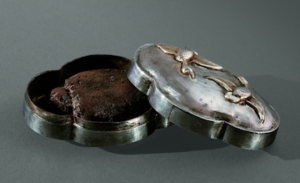
PROCEEDINGS OF THE NATIONAL ACADEMY OF SCIENCES—A study* identifies aromatic compounds associated with incense offered at a Buddhist temple during the Tang Dynasty in China. Incense plays many cultural roles, including a role in religious worship, and was a key product traded between China and other countries via the Silk Road trade network. Texts from the Tang Dynasty in China, dated to between 618 and 907 CE, report the introduction of exotic aromatic substances in China, albeit with rare archaeological evidence. Yimin Yang and colleagues chemically analyzed incense compounds discovered at the underground palace of the Famen Temple near Xi’an, China. The temple was constructed to house a finger bone relic purported to belong to the founder of Buddhism, and multiple containers of incense were discovered during excavation of the temple site. Using Fourier-transform infrared spectroscopy and gas chromatography/mass spectrometry analysis, the authors identified elemi resin and highly scented agarwood, respectively, in two of the containers. Another container held a mixture of agarwood and frankincense, providing the earliest known evidence of the aromatics blending practice known as Hexiang. According to the authors, the results show the contemporary knowledge of exotic incense during the Tang Dynasty and demonstrate the Silk Road’s influence on ancient Chinese society.
________________________________________

The begonia-shaped silver container with the aromatic powder (Hexiang) inside, discovered in the underground palace of Famen Temple. Xinlai Ren and Xinyi Wang
________________________________________
Article Source: PNAS news release
*“Characterization of the incense sacrificed to the sarira of Sakyamuni from Famen Royal Temple during the ninth century in China,” by Meng Ren, Xinlai Ren, Xinyi Wang, and Yimin Yang, Proceedings of the National Academy of Sciences, 16-May-2022. 10.1073/pnas.2112724119
________________________________________
Advertisement





